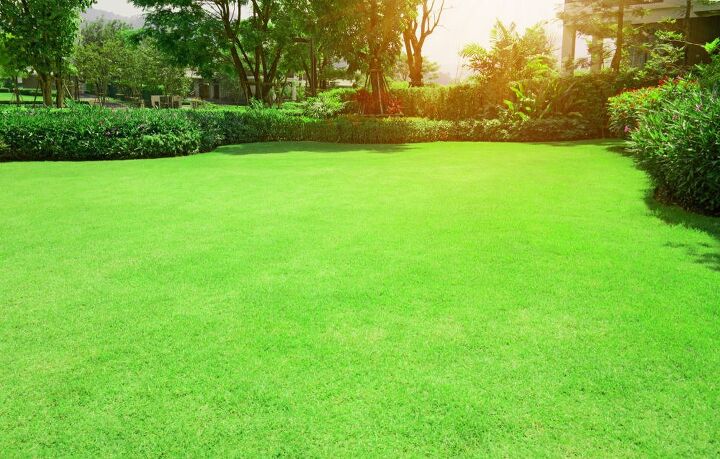Bermuda Vs. Zoysia Grass: What Are The Major Differences?

Choosing between sod and grasses is not only aesthetic but also often about function and climate. One grass may be better looking while another may be better suited for the environment that you live in. Two common tropical types of grass are Bermuda and Zoysia, but what’s the difference between them, and which is better?
Zoysia grass is ideal for slightly cooler temperatures and requires moderate sunlight to grow well. Bermuda grass, however, thrives in direct sunlight and needs high temperatures to grow to its full potential. Both plants are perennial and can be planted during the late spring to achieve the best ground coverage and color.
Each of these types of grass has unique life cycles, water needs, and characteristics that make them appealing. Follow along as we take a look at the key differences between Zoysia and Bermuda grass, and what makes them unique.
Do You Need Landscaping Services?
Get free, zero-commitment quotes from pro contractors near you.

Bermuda
Bermuda grass is a staple of tropical climates that many homeowners plant for its distinct appearance. You can spot Bermuda grass by its distinct green and gray color and dense formation that makes it durable. Because Bermuda grass is a perennial and will return year after year, it’s an ideal choice for homeowners that don’t want to replant.
Bermuda grass is unique in how durable and large its root system is, and that makes it handle foot traffic. Its roots can grow 6 feet down, or even further, and that is good news for the grass and your soil. As long as you have plenty of sunlight and adequate soil drainage, Bermuda grass is a great addition to any yard.
Growth
Bermuda grass grows easily, but it requires full and direct sunlight to reach maximum potential. Germination can take as long as 30 days, but Bermuda grass can germinate in just one week in some cases. However, it can take up to 6 weeks before Bermuda grass forms a turf that is suitable for heavy foot traffic.
Bermuda grass reaches thick and dense growth around the 10-week mark if you plant it in the late spring before summer comes. Growth can take up to 14 weeks if you plant the Bermuda grass too early in the spring, or at the beginning of summer. Never plant Bermuda grass in the fall season as it will surely die once the first frost of the season hits.
Pests
Roundworms, or nematodes, are one of the most common pests that go after your Bermuda grass. It can be difficult to detect nematodes in the early stages of infestation, but yellow spots on the blades indicate roundworms. Check the blades of the Bermuda grass for small holes and bite marks that would show that roundworms have made their way to your yard.
Bermuda mites are another common Bermuda grass pest, and they can be quite destructive if left untreated. Pesticides are not the answer when it comes to Bermuda mites, and water is your best bet to get rid of them. You can eliminate Bermuda mites by spraying down your yard and soaking it with 1” of water.
It’s best to spray your Bermuda grass with water after mowing it so that you do the most damage to them. Besides pests, Bermuda grass can fall victim to fungal infestations that cause spots and darkening of the blades. Luckily, however, you can use a fungicide product, such as Bonide, to treat your Bermuda grass for fungal infestations.
Life Cycle
When you plant Bermuda grass in the late spring, you can expect it to last until October or November. It mostly depends on your local climate and how long it takes for it to become cold and frost. This dormant time occurs because Bermuda grass is tropical and simply cannot live and thrive through frost and cold winter.
However, once you reach February or March, you should notice your Bermuda grass begin to come back slowly. Because it’s perennial grass, you can count on it growing strongly once again by the time that you reach April or May. If the temperature drops below 55 degrees Fahrenheit during this time, however, your Bermuda grass may not make it.
Zoysia
Zoysia grass looks different from Bermuda right away because of its dark green color in the blades. Another key difference between Zoysia and Bermuda is that Zoysia has blades that are firm and stiff. Zoysia grass is also unique in that it thrives in cooler temperatures, 75 degrees Fahrenheit and below, and not in the heat.
Root depth varies between Zoysia and Bermuda grass, and Zoysia roots only generally grow 2 feet deep. Zoysia is considered low maintenance because it doesn’t need much fertilizer to grow to be strong. If you mow your Zoysia grass no shorter than 1 ½”, you can expect it to grow strong and vibrantly.
Growth
You can plant Zoysia grass during the fall or spring as long as you time it so that a frost won’t hit. Plant your Zoysia at least 2 months before an expected frost if you choose the fall time for germination. The seeds can take up to 3 weeks to germinate, but Zoysia seeds can germinate in as little as 14 days.
If you plant the Zoysia as plugs, then it will be at least 2 years before you see the entire yard or pasture covered. Once Zoysia seeds are planting, you can see some form of growth by the 21-day mark if properly cared for. You only need to water Zoysia with 1” of water, and oftentimes ½” is enough for healthy growth.
For every 1,000 square feet of Zoysia grass, you will need up to 4 pounds of nitrogen each season. Luckily, nitrogen is readily available in the form of fertilizer, and it works like a charm to make a lush Zoysia lawn. Only apply fertilizer to Zoysia grass soil when it is dry, otherwise, you run the risk of it burning and damaging the lawn.
Pests
Nematodes eat and destroy Zoysia grass just like they tend to do with Bermuda grass, and water can take care of that. Mole crickets are another common pest that is destructive to Zoysia grass, and they are present all year in places like Florida. Some homeowners treat their Zoysia for mole crickets by dousing the lawn with a mixture of dish soap and water.
Zoysia grass also falls victim to grubs (beetle larvae) and beetles that gnaw on the blades and weaken the grass. You can get rid of lawn grubs using chemicals such as trichlorfon and carbaryl, and then spray them with water afterward. However, the most destructive type of pest that is attracted to Zoysia grass is the menacing chinch bug.
Chinch bugs are easy to spot by their dark and white or dark and red markings on their backs. The effects of chinch bugs destroying Zoysia are almost identical to the effects of a drought. Luckily, just about any granular insecticide in concert with a light layer of water is enough to remove chinch bugs.
Life Cycle
Zoysia is perennial much like Bermuda grass, and it can come back strong year after year. However, during its dormant time, you must give the Zoysia grass ¼” of water biweekly so that it bounces back well. During the dormant time, the fall and winter, you’ll notice that your Zoysia grass turns somewhat tan and or brown, but that doesn’t mean it’s dead.
Your Zoysia grass should bounce back and turn green by April, May, or June if temperatures steadily increase. Luckily, Zoysia is not overly sensitive to changes in temperature and sunlight unless it gets too cold, or into the upper 80s. Don’t fret if your Zoysia grass turns brown shortly after planting them if you aim for fall as they will be green by the late spring.
Which Is Better?
If you live in a dry, sunny climate, Bermuda grass is better, but if you have cold spells then Zoysia grass is better. Zoysia can handle cooler temperatures without dying and turning brown right away like Bermuda grass can. However, if you live somewhere like Florida, California, or Texas, Bermuda will thrive better than Zoysia due to the constant sunlight.
It’s also worth considering that Zoysia grass can spread wildly to places that you may not necessarily have intended. Bermuda grass can sometimes grow wildly when given too much sun leading homeowners to kill it by smothering areas of the lawn. Between the two of them, Zoysia grass is less maintained than Bermuda grass, and it is slightly better because of that.
Do You Need Landscaping Services?
Get free, zero-commitment quotes from pro contractors near you.

Summing It Up
Zoysia and Bermuda grass are both perennial, thick, and durable grasses that are easy to care for. However, Zoysia is slightly easier because of how well it can handle cold weather without dying right away. Bermuda grass has a root system that is often 4 feet deeper than Zoysia, and that makes it more dense and durable.
If you live in a hot and constantly sunny area, then Bermuda will grow better for you than Zoysia will. Zoysia does not need much in the way of fertilizer like Bermuda often does, and that makes growing it somewhat easier. Both plants are susceptible to pests such as nematodes and mole crickets, and you’ll need to watch for fungal infestations.
Bermuda grass can become invasive, and you can get rid of it by choking it out or using a simple weed killer. Zoysia is the better option if you live in a cooler climate, and Bermuda is perfect for hot, tropical climates.

Nick Durante is a professional writer with a primary focus on home improvement. When he is not writing about home improvement or taking on projects around the house, he likes to read and create art. He is always looking towards the newest trends in home improvement.
More by Nick Durante



























